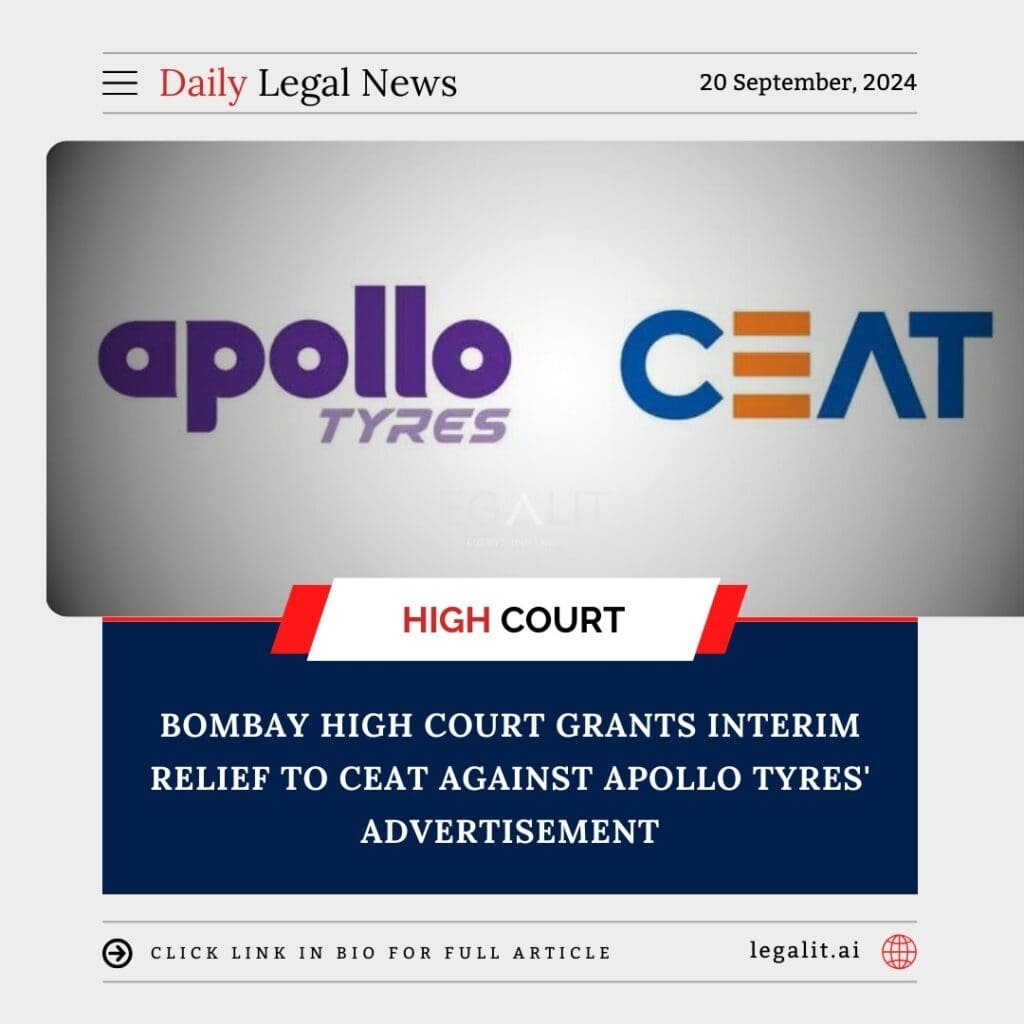
In a recent legal tussle between two of India’s leading tyre manufacturers, the Bombay High Court has granted interim relief to CEAT in a dispute with Apollo Tyres over a controversial advertisement. CEAT had filed a case alleging that Apollo Tyres’ ad unfairly disparaged its products and misled consumers, leading to damage to its brand image. The court’s decision temporarily halts Apollo Tyres from airing the advertisement until further deliberation.
Background of the Dispute
The conflict arose from an advertisement released by Apollo Tyres, which CEAT claims was crafted in a manner that implicitly targeted and disparaged CEAT’s products. While the ad did not explicitly mention CEAT, the portrayal of rival tyres in a negative light through visual cues, indirect references, and product comparisons led CEAT to take legal action.
CEAT argued that the ad was not only misleading but also amounted to disparagement under Indian law, specifically in relation to the Monopolies and Restrictive Trade Practices Act. CEAT claimed that Apollo Tyres had deliberately aimed to harm its reputation and market share by portraying its products as inferior.
CEAT’s Key Arguments
In its plea to the Bombay High Court, CEAT raised several arguments to support its request for interim relief:
- Implied Disparagement: CEAT’s primary argument was that Apollo Tyres’ ad indirectly disparaged its products by highlighting certain negative characteristics that could easily be associated with CEAT’s tyres. CEAT maintained that the ad aimed to create a negative perception about its products without directly naming the brand, thus misleading consumers.
- Misleading Representation: CEAT contended that the advertisement used visual and verbal cues to mislead consumers into believing that Apollo’s tyres were superior in terms of safety, performance, and durability, without any substantial evidence or comparative testing to back up these claims. This, CEAT argued, violated principles of fair advertising.
- Brand Reputation: CEAT further argued that its reputation as a market leader in the tyre industry was at stake. The company claimed that the ad created unnecessary doubt among consumers about the quality of CEAT’s products, potentially leading to a loss in customer trust and market share.
Apollo Tyres’ Defense
On the other hand, Apollo Tyres defended its advertisement by claiming that it adhered to industry standards for comparative advertising. According to Apollo, the ad was focused on promoting its own product’s strengths rather than targeting or disparaging any specific competitor. The company argued that comparative advertising is a legitimate marketing tool used globally, and as long as the ad does not explicitly defame a rival, it is well within legal boundaries.
Apollo Tyres also maintained that the ad was based on verifiable data showcasing the advantages of its product over generic competitors, and there was no intentional targeting of CEAT.
Court’s Decision and Interim Relief
After hearing the arguments from both sides, the Bombay High Court decided to grant interim relief to CEAT, temporarily halting Apollo Tyres from airing the disputed advertisement. The court’s key observations were:
- Potential Disparagement: The court found merit in CEAT’s claim that the advertisement could lead to consumer confusion and implied disparagement. While Apollo Tyres did not explicitly name CEAT, the court agreed that the visual and verbal elements could be perceived as targeting CEAT’s products.
- Consumer Protection: The court highlighted the importance of ensuring that advertisements do not mislead consumers, especially when it comes to comparative advertising. Since Apollo Tyres’ claims could potentially influence consumer choices based on unclear or unverified comparisons, the court deemed it necessary to restrain the ad until further evaluation.
- Balance of Convenience: The court also noted that the balance of convenience tilted in favor of CEAT, as the continued airing of the advertisement could cause irreparable harm to CEAT’s reputation and market position, while halting the ad would not cause significant harm to Apollo’s business in the interim.
Implications of the Ruling
The Bombay High Court’s ruling in favor of CEAT has several implications for both the tyre industry and the broader landscape of comparative advertising in India:
- Advertising Standards: The case highlights the thin line between fair comparative advertising and product disparagement. The ruling reinforces the need for companies to ensure that their advertisements remain within the boundaries of fair competition and do not mislead consumers or malign rival products.
- Consumer Protection: The court’s decision also emphasizes the role of consumer protection in advertising disputes. Misleading claims, even if indirect, can have a significant impact on consumer decisions, and the judiciary plays a crucial role in safeguarding consumer interests.
- Industry Competition: The interim relief granted to CEAT sends a message to competitors in the tyre industry and beyond that aggressive marketing tactics targeting rival products can lead to legal consequences, especially if they result in brand disparagement or consumer confusion.
- Future Advertising Campaigns: This case could set a precedent for how comparative advertising is approached in the Indian market. Companies may now take greater care in designing their marketing campaigns to avoid potential legal challenges, especially in highly competitive sectors like automotive and consumer goods.
Conclusion
The Bombay High Court’s decision to grant interim relief to CEAT against Apollo Tyres in the ongoing advertising dispute underscores the importance of maintaining ethical standards in competitive advertising. By halting the advertisement, the court has given CEAT the opportunity to protect its brand reputation while ensuring that Apollo Tyres’ marketing tactics adhere to fair trade practices. The case will likely shape future advertising strategies, especially in industries where product comparison is a key aspect of marketing.